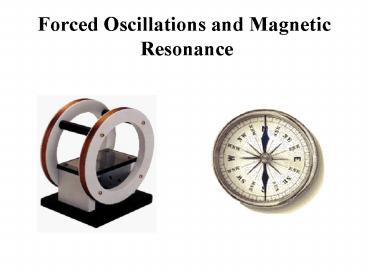Forced Oscillations and Magnetic Resonance - PowerPoint PPT Presentation
1 / 30
Title:
Forced Oscillations and Magnetic Resonance
Description:
TORQUE is a measure of how much a force acting on an object. causes that object to rotate. ... There are three forces acting on the compass. needle: 1) magnetic ... – PowerPoint PPT presentation
Number of Views:50
Avg rating:3.0/5.0
Title: Forced Oscillations and Magnetic Resonance
1
Forced Oscillations and Magnetic Resonance
2
A Quick Lesson in Rotational Physics
TORQUE is a measure of how much a force acting on
an object causes that object to rotate.
Moment of Inertia, I, is the rotational analogue
to mass. Angular acceleration, , is the
second derivative of angular position.
3
Newtons Second Law of Motion
Rotational Equivalent of Newtons Second law
Where t is the torque I is the moment of
inertia is the angular acceleration
4
Diagram of the magnetic field due to both coils,
along with the angle associated with the angular
displacement from equilibrium.
5
There are three forces acting on the compass
needle 1) magnetic force due to Helmholtz
coils 2) magnetic force due to inner coils 3)
damping force due to friction between the
compass needle and the holding pin Since we are
dealing with rotational motion, these forces are
actually torques.
6
Constants and Variables
- B magnetic induction due to Helmholtz coils
- b damping constant
- F amplitude of the driving field
- w the driving frequency
- m dipole moment of the compass needle
- I rotational inertia of the compass needle
- q angular displacement from equilibrium
7
Newtons Second Law of Motion(rotational)
- tnet tdriving field trestoring tdamping
8
The torque due to the driving field is
The torque due to the restoring field is
The torque due to the damping force is
9
The Second Order Differential Equation
Which corresponds to Newtons Second Law of
Motion
tnet tdriving field trestoring tdamping
10
Dividing through by I, the rotational inertia,
and rearranging gives
then we let...
11
Substituting w02 and w12 into the differential
equation yields
12
We assume a particular solution
Since we are dealing with a oscillatory function
it makes sense to assume the most general
oscillatory solution involving the two
oscillatory functions, sin and cos.
13
Solving for c1 and c2 we get
14
Letting
This is the denominator of the c1 and c2 solutions
15
Further calculations lead us to the following
equation
16
We can rewrite the particular equation, by using
some simple trigonometry
where
17
Through further calculations we can rewrite our
particular solution in terms of amplitude of
the driving field
We want to do this, in order to use our
experimental data directly in the equation. The
ratio in front of the cosine function is the
amplitude of the compass needle.
18
Lets introduce a new relationship,
With any kind of wave motion the relationship of
the oscillatory energy is directly proportional
to the square of the amplitude of the motion.
19
F which is the amplitude of the driving field,
remains constant, thus the relationship
can lead us to the conclusion
In other words, when z is at a minimum, the
oscillatory energy of the compass needle is at a
maximum
20
-When we take the derivative of z and set it
equal to zero, that is when z is at a minimum.
-When z is at a minimum, E, oscillatory energy,
is at a maximum. -When E is at a maximum, the
deflection of the compass needle is at a
maximum, and we get resonance.
21
When solved for w2 will yield
22
Using the fact that
We can make a substitution and come up with
23
Rearranging and making the substitution
Gives us the final equation
24
The following graph was generated from
experimental data
25
The graph is a line with the equation in the form
of
Where f2 is the frequency measured, i is the
current measured, A is the slope of the graph
which is directly proportional to the ratio
, and B is the y-intercept which is directly
proportional to
Thus, we now can determine from our experimental
data that the magnetic dipole moment-rotational
inertia ratio to be 3.66 106, and the damping
constant 2.03 10-5 .
26
(Current used 1A)
27
(Current used 1A)
28
(Current used 5A)
29
(Current used 5A)
30
The NMR for ethyl acetate, C4H8O2

